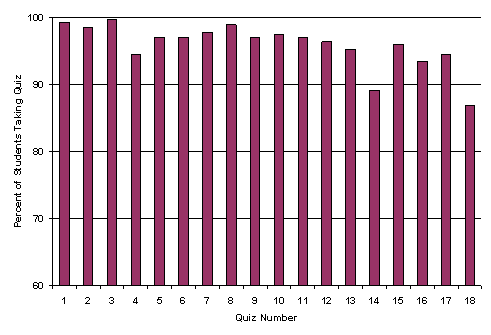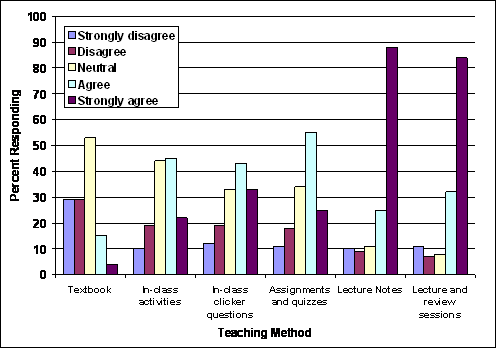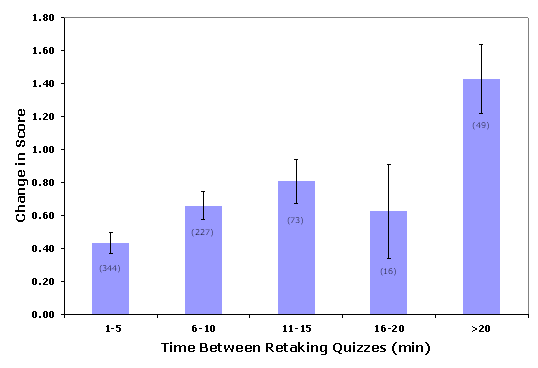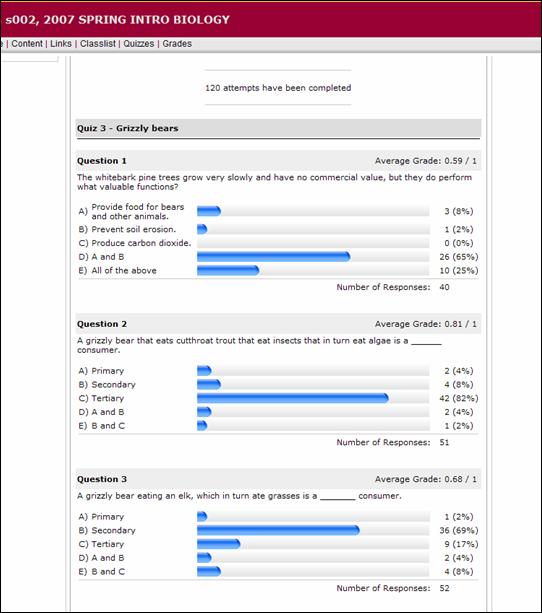|
Introduction
Instructors often integrate case studies,
assignments and quizzes into their classes for many
different reasons. Case studies and assignments can
help students apply information previously learned
in class to solve new problems. Through the
analysis of data, interpretation of results and
reading of specific articles, students may probe
deeper into a particular topic than through lecture
alone. Research indicates that understanding is
more likely to develop when students engage in
activities such as analysis, evaluation,
interpretation, prediction, and explanation
(Bransford, Brown & Cocking, 1999; Coleman, 1998;
Coleman, Rivkin & Brown, 1997). Quizzes are also
often used as an incentive for students to keep up
with the material between exams and can provide
students with valuable formative feedback on what
concepts they need to review. Moreover, assignments
and quizzes can be used by faculty for assessment of
student learning and identification of
misconceptions. However, the time required to grade
quizzes may impede an instructor’s ability or desire
to give assignments and quizzes, especially in
larger introductory courses. The objective of this
project was to create homework assignments for large
classes that could be evaluated through the use of
online quizzes with minimal effort by the
instructor. Moreover, we monitored student use of
online quizzes, allowed students to retake quizzes,
and evaluated the relation of improvement in quiz
scores and time between attempts.
Literature Survey
Most instructors teaching courses in the life
sciences would like to engage students in learning
outside of class through reading assignments and
other activities. However, large class sizes,
especially in introductory biology courses, make
instructors reticent to assign homework because of
the inordinate amount of time required to grade and
assess assignments. Computer-based assignments and
assessment offer a mechanism to minimize the time
required by instructors to evaluate student
performance.
Recent research has focused on comparing the
effectiveness of online and traditional lecture or
paper-based teaching methods. Much of this work has
been done in the physical sciences (astronomy,
chemistry and physics) where students can be given
numerical problems to solve, or explain phenomena
using equations. In several studies there was no
difference in scores between homework assignments
given in a traditional paper-based format versus
those given online (Cole & Todd, 2003; Bonham et
al., 2003; Allain & Williams, 2006, Bunce, et
al., 2006). However, Dufresne et al.
(2002) reported a slight increase in test scores by
students completing assignments online. Hence,
these results suggest that completing homework
online is neither inferior nor superior to
traditional paper-based assignments. However,
online homework may offer a substantial advantage to
the instructor through a reduction in the amount of
time required in grading.
A challenge of online quizzes in the life sciences
is that the issues being discussed cannot always be
reduced to numerical answers or equations and are
often much more conceptual or descriptive than those
in the physical sciences. As a result, online
quizzes may become tests of rote memorization and
factual recall. One solution to this problem is to
give students open-ended assignments and homework
questions, and then give an online quiz to assess
student completion of the homework assignment and
understanding of the material. Moreover, this
permits instructors to show connections between
biological concepts and news stories in the popular
press, which allows students to see how the
theoretical concepts they are learning in class are
applied in the real world. Such issues-based
biology courses are becoming more common, especially
for non-majors (Stover & Mabry, 2005).
Methods
The authors linked class assignments with online
quizzes in a 14-week non-majors introductory biology
course which had two to three lecture sections with
80 to 120 students in each section. During the
semester, students completed 18 to 20 assignments
(Table 1) and online quizzes on the content from
each assignment. Students were allowed two to five
days to complete the assignment and quiz. Each quiz
consisted of five multiple-choice questions chosen
randomly from a pool of 10 to 20 questions based on
the assignment. Once a student began a quiz, they
had five minutes to complete it. This time limit
was intended to minimize students’ ability to look
up answers rather than recalling the information.
Students were allowed to take each quiz twice, and
their highest score was recorded. Because the
questions were generated randomly, the second quiz
differed from the first. Students immediately saw
their quiz results upon completion, although the
correct answers to questions were not revealed.
Students then had the option of reviewing the
assignment before taking the quiz a second time;
students could re-take the quiz immediately or delay
taking the quiz up until the deadline for the
assignment. Providing students with a second
chance to learn from their mistakes is an effective
way to increase proficiency using online assignments
(Hall et al., 2001). The quizzes were
automatically generated, scored, and grades were
recorded by a web-based course management system,
Desire2Learn (D2L). Students were asked to complete
course assignments and online quizzes once or twice
per week. After creating the assignments and
writing the quiz questions, instructor oversight was
minimal. The D2L system also recorded the time each
student took each quiz and the answers they choose,
which can be useful assessment information for
instructors.
The designs of the assignments varied, but all
assignments included a set of questions for students
to consider after they read an article or analyze
data. In addition, each assignment addressed a
topic being covered simultaneously in lecture.
The online quizzes then tested the students’
understanding of the assignment and the associated
questions they were asked to answer. The students
did not turn their assignments in to the instructor,
and the instructor did not manually grade quizzes.
Our assignments were based on diverse sources (Table
1), including articles from the popular press (New
York Times, etc.), Scientific American and readings
from the textbook. Several assignments were linked
to websites that included simulations or data sets,
while other assignments required students to use
both text and online material. Thus, one of the
strengths of this approach is that instructors can
incorporate a variety of material from different
sources into assignments.
Table 1: Topics for General Biology Assignments and
Quizzes
|
Quiz |
Assignment – Article |
Assignment - Website |
|
1 |
Scientific Method |
Graduate Student Experiment |
AquaRush |
|
2 |
Populations |
|
US Census, Nationmaster |
|
3 |
Community Interactions |
NYT article on “In the Rockies, Pines Die and
Bears Feel It” |
|
|
4 |
Nutrient Cycles |
Discover article on “The Nitrogen Bomb” |
|
|
5 |
Obesity Epidemic |
|
Centers for Disease Control, National Heart,
Blood and Lung Institute |
|
6 |
Biological Molecules |
NYT article on “Science's Quest to Banish Fat in
Tasty Ways” |
Cells Alive, Wisc-Online |
|
7 |
Enzymes and Energy |
From textbook, “Missing Molecule Makes Mischief”
on PKU. |
Newborn screening tests, Enzyme Activity. |
|
8 |
Respiration and Metabolism |
|
Centers for Disease Control, Ben’s Bad Day |
|
9 |
Photosynthesis |
From textbook, why chlorophyll is green, meat is
red and blood from mussels is blue. |
Fall Colors, |
|
10 |
Meiosis |
From textbook, what determines gender |
PBS |
|
11 |
Mitosis |
NYT article “Your Body Is Younger Than You
Think” |
|
|
12 |
Genetics |
Hemophilia case study from SUNY |
SUNY |
|
13 |
Molecular Biology |
From textbook, cystic fibrosis |
OMIM, Hemophilia background, Cystic fibrosis
background |
|
14 |
Biotechnology |
Scientific American article “The Land of MILK &
MONEY” |
|
|
NYT article “Embryonic Cells, No Embryo Needed:
Hunting for Ways Out of an Impasse” |
|
15 |
Evolution |
|
|
16 |
Natural Selection |
|
Natural Selection Simulation |
|
17 |
Speciation |
|
Speciation Simulation |
|
18 |
Human Evolution |
Scientific American article “Lucy’s Baby” |
|
Results
Because the quizzes and assignments were linked and
were developed simultaneously, there was not any
direct pre- and post-assessment of student
learning. Instead the goal of this project was to
find a reasonable method to create graded homework
assignments for large classes and monitor student
use of the quizzes. The “online attendance” of 240
students taking 18 quizzes over three semesters was
95.7% and decreased slightly over the course of the
semester (Figure 1).
Students were asked to rate six different teaching
methods used in the class by evaluating the
following statement “The ______ helped me to
understand the material.” as strongly disagree,
disagree, neutral, agree, or strongly agree (Figure
2). Results from 140 students surveyed indicated
that lectures and lecture notes were ranked most
favorably, while the textbook and in-class
activities were ranked least favorably. Student
evaluations of online assignments and quizzes were
tied with personal response system questions, and
the majority of the class either agreed or strongly
agreed that these teaching techniques helped them to
understand the material.

Figure 1. Percentage of students taking each quiz.
Values are the mean number of students over three
semesters (n=240).
Several interesting patterns were observed in
student quiz-taking strategies and behaviors.
Students were allowed to take the quiz twice, with a
five minute time limit per quiz, and only the
highest score was recorded. Students getting a
perfect score were encouraged to take the quiz a
second time for practice, yet only 19.6% took this
advice. Students missing at least one question on
the quiz were advised to take the time to review the
assignment again before using up their second
attempt. Of those who missed at least one question
on their first attempt, 1.7% did not try again,
74.9% completed their second attempt within 10
minutes (average time = 4.6 minutes), and 23.4%
completed their second attempt at least 10 minutes
after their first attempt (average time = 21.6
minutes). Given the five minute time limit to take
the quiz, it is unlikely that students had time to
review the assignment in less than 10 minutes, and
these students most likely took the quiz a second
time immediately after their first attempt. On
average, these students scored half a point better
on their second attempt than their first, suggesting
that getting some immediate feedback from the first
attempt did improve their performance on the second
attempt. However, students who took at least 10
minutes between attempts scored twice as well on
their second quiz (Figure 3, p=1x10-6 by
t-test), consistent with improved performance after
reviewing the assignment.

Figure 2. Introductory Biology student ratings of
different teaching methods. Students were asked if
each of the teaching methods helped them to
understand the material using the scale indicated in
the legend. (n=140).

Figure 3. Time lapsed between quiz attempts vs.
mean change in score between attempts. Numbers in
parentheses indicate the number of students in each
category.
Overall the instructors felt that the additional
effort involved in generating the assignments with
linked quizzes was worthwhile. The students seemed
more engaged in the material, and were better
prepared for problem-solving exam questions. The
authors were also able to give students formative
assessment by reviewing the quizzes in class each
week, as the D2L site gives instructors information
on how many students chose each answer for each
question (Figure 4). In this way instructors can
identify where the class was having problems, and
which wrong answers were being chosen. This
feedback could then be used in class, and any
confusing topics discussed again.

Figure 4. Quiz results based on the New York Times
article, “In the Rockies, Pines Die and Bears Feel
It.” By Charles Petit, January 30, 2007.
Discussion
Benefits to the Students
The authors feel that the students benefit from the
online assignments and quizzes in several ways.
This approach requires the students to work with the
subject material presented in lecture four to five
times between exams. This reduces the amount of
last-minute cramming that many first-year students
rely on to prepare for exams. The “online
attendance” of 95.7% in the current study was
similar to other studies of student performance of
online assignments. For example, Riffel & Sibley
found that 93% of students participated online but
only 78% physically attended class. Moreover, these
online assignments and quizzes allow students to see
how the concepts they are learning in lecture apply
in the real world. The use of science articles from
the popular press reinforces the concept that
subjects covered in class appear in the news every
day and , as an informed citizen, they should be
able to read a newspaper article and understand it.
Finally, the students get direct formative feedback
of their progress in the class well before any
exams. Formative assessment is more valuable than
summative assessment, as students have time to learn
from their mistakes and correct any misconceptions
early on in their learning process (Cooper et al.,
2006).
Benefits to the Teacher
As teachers we frequently struggle with ways to
engage our students in the subjects we teach.
Instructors often strive to involve students in
hands-on exploration, discussion, and writing.
However,
given large class sizes and other instructional
responsibilities, such teaching strategies are
difficult to implement.
The use of online assignments, coupled with online
multiple choice quizzes written to assess student
understanding of the key points of the assignment,
allows instructors to increase student engagement in
an efficient manner. Most of the effort in this
project was in creating the assignments and
accompanying questions, writing the quiz questions,
and programming this into D2L. Since then, the same
assignments and quizzes have been used in multiple
lecture sessions for three years. Each year a few
of the assignments and quizzes are changed as new
articles become available. The use of the
assignments and quizzes has also allowed removal
from lecture of some material that required only
rote memorization by the students. Instead,
students visit websites that contain this content,
thus making time for in-class assignments and
questions. One limitation of this approach is a
reliance on multiple choice questions. Instructors
can choose questions that require analysis of data,
instead of reciting definitions or content.
Conclusions
Linking diverse assignments, including readings,
case studies, analysis of databases and websites
with an online quiz allows instructors to more fully
engage students and encourages them to explore
subject material in a more complex manner, while
requiring only a modest increase in instructional
effort. This allows an instructor to increase the
frequency of assignments, keeping the students
engaged in the material between exams. It also
allows students to explore multiple topics in depth,
which is especially useful in a broad introductory
class. With the diverse format of the assignments,
this method should be applicable in many different
disciplines in both science and non-science
courses.
References
Allain, R. and Williams, T. (2006). The
Effectiveness of Online Homework in an Introductory
Science Class. Journal of College Science
Teaching, May/June, 28-30.
Bonham, S.W., Deardorff, D.L., Beichner, R.J.
(2003). Comparison of student performance using web
and paper-based homework in college-level physics.
Journal of Research in Science Teaching, 40(10),
1050–1071.
Bransford, J.D., Brown, A.L. & Cocking, R.R.
(Editors). (1999). How People Learn: Brain, Mind,
Experience and Schooling. Washington, DC: National
Academy Press.
Bunce, D.M., VandenPlas, J.R. and Havanki, K.L.
(2006). Comparing the Effectiveness on Student
Achievement of a Student Response System versus
Online WebCT Quizzes. Journal of Chemical
Education, 83(3), 488-493.
Cole, R.S. and Todd, J.B. (2003). Effects of
Web-Based Multimedia Homework with Immediate Rich
Feedback on Student Learning in General Chemistry.
Journal of Chemical Education, 80(11), 1338-1343.
Coleman, E.B. (1998). Using explanatory knowledge
during collaborative problem solving in science.
Journal of the Learning Sciences, 7(3-4), 387-427.
Coleman, E.B., Rivkin, I.D. & Brown, A.L. (1997).
The effect of instructional explanations on learning
from science texts. Journal of the Learning
Sciences, 6(4), 347-365.
Cooper, S., Hanmer, D. and Cerbin, W. (2006).
Problem Solving Modules in Large Introductory
Biology Lectures Enhance Student Understanding.
American Biology Teacher, 68, 524-9.
Dufresne, R., Mestre, J., Hart, D.M., Rath, K.A.
(2002). The effect of web-based homework on test
performance in large enrollment introductory physics
courses. Journal of Computers in Mathematics and
Science Teaching 21(3), 229-251.
Hall, R.W., Butler, L.G., McGuire, S.Y., McGlynn,
S.P., Lyon, G.L., Reese, R.L. and Limbach, P.A.
(2001). Automated, Web-Based, Second-Chance
Homework. Journal of Chemical Education, 78(12),
1704-1708.
Perkins, D.N. (1998). What is understanding? In M.
Stone-Wiske (Editor), Teaching for Understanding:
Linking Research With Practice. San Francisco, CA:
Jossey-Bass.
Riffell, S.K. and Sibley, D.F. (2004). Can Hybrid
Course Formats Increase Attendance in Undergraduate
Environmental Science Courses? J. Nat. Resour. Life
Sci. Educ., 33, 1-5.
Stover, S. and Mabry, M. (2005). Merging Science
and Society: An Issues-Based Approach to Nonmajors
Biology. Journal of College Science Teaching,
Jan/Feb, 40-43.
|
